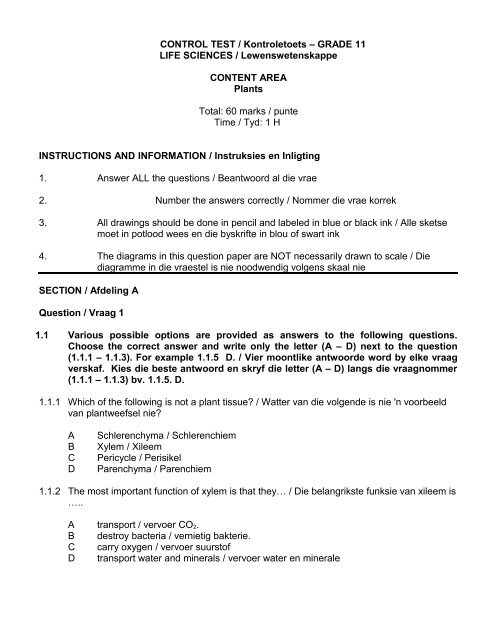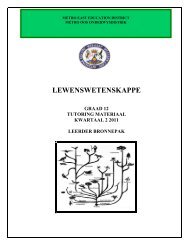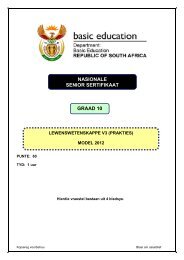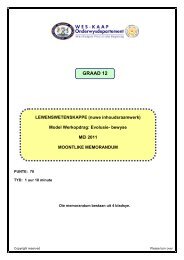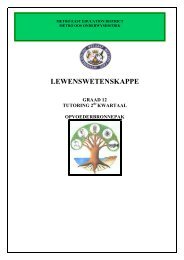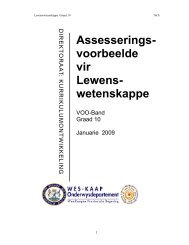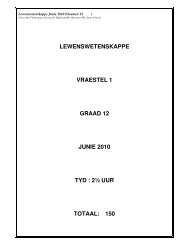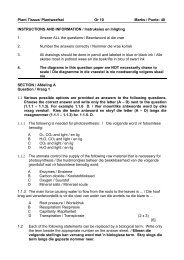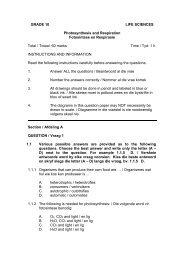CONTROL TEST – GRADE 10
CONTROL TEST – GRADE 10
CONTROL TEST – GRADE 10
You also want an ePaper? Increase the reach of your titles
YUMPU automatically turns print PDFs into web optimized ePapers that Google loves.
<strong>CONTROL</strong> <strong>TEST</strong> / Kontroletoets <strong>–</strong> <strong>GRADE</strong> 11<br />
LIFE SCIENCES / Lewenswetenskappe<br />
CONTENT AREA<br />
Plants<br />
Total: 60 marks / punte<br />
Time / Tyd: 1 H<br />
INSTRUCTIONS AND INFORMATION / Instruksies en Inligting<br />
1. Answer ALL the questions / Beantwoord al die vrae<br />
2. Number the answers correctly / Nommer die vrae korrek<br />
3. All drawings should be done in pencil and labeled in blue or black ink / Alle sketse<br />
moet in potlood wees en die byskrifte in blou of swart ink<br />
4. The diagrams in this question paper are NOT necessarily drawn to scale / Die<br />
diagramme in die vraestel is nie noodwendig volgens skaal nie<br />
SECTION / Afdeling A<br />
Question / Vraag 1<br />
1.1 Various possible options are provided as answers to the following questions.<br />
Choose the correct answer and write only the letter (A <strong>–</strong> D) next to the question<br />
(1.1.1 <strong>–</strong> 1.1.3). For example 1.1.5 D. / Vier moontlike antwoorde word by elke vraag<br />
verskaf. Kies die beste antwoord en skryf die letter (A <strong>–</strong> D) langs die vraagnommer<br />
(1.1.1 <strong>–</strong> 1.1.3) bv. 1.1.5. D.<br />
1.1.1 Which of the following is not a plant tissue? / Watter van die volgende is nie 'n voorbeeld<br />
van plantweefsel nie?<br />
A Schlerenchyma / Schlerenchiem<br />
B Xylem / Xileem<br />
C Pericycle / Perisikel<br />
D Parenchyma / Parenchiem<br />
1.1.2 The most important function of xylem is that they… / Die belangrikste funksie van xileem is<br />
…..<br />
A transport / vervoer CO2.<br />
B destroy bacteria / vernietig bakterie.<br />
C carry oxygen / vervoer suurstof<br />
D transport water and minerals / vervoer water en minerale
1.1.3 The stomata control the supply of the following raw material that is necessary for<br />
photosynthesis: / Die huidmondjies beheer die verskaffing van die volgende<br />
grondstowwe wat benodig word vir fotosintese:<br />
A. Enzymes / Ensieme<br />
B. Carbon dioxide / Koolstofdioksied<br />
C. Oxygen / Suutstof<br />
D. Mineral salts / Minerale soute<br />
(2 x 3) (6)<br />
Each of the following statements can be replaced by a biological term. Write only<br />
the term beside the appropriate number on the answer sheet. / Elkeen die volgende<br />
stellings kan vervang word met 'n biologiese term. Skry slegs die term langs die<br />
gepaste nommer neer.<br />
1.2.1 Unicellular root. / Eensellige wortel.<br />
1.2.2 Pressure due to the intake of water by the roots. / Druk as gevolg van die inname van<br />
water deur die wortels.<br />
1.2.3 The process where a substance moves against the diffusion gradient. / Die proses waar 'n<br />
stof teen die diffussie gradiënt beweeg.<br />
1.2.4 The loss of water droplets from leaves when the soil is damp and the air is humid. / Die<br />
verlies van water druppels by blare wanneer die grond en die lug vogtig is.<br />
(1 x 4) (4)<br />
1.3 Choose an item from COLUMN A that matches a description in COLUMN B. Write<br />
only the letter (A <strong>–</strong> K) next to the question number (1.3.1 <strong>–</strong> 1.3.5), for eg. 1.3.6 J.<br />
COLUMN A COLUMN B<br />
1.3.1 Lignine / Lignien A. Fatty substance. Vetterige stof<br />
1.3.2 Chlorophyll B. Found in xylem / Teenwoordig in<br />
xileem<br />
1.3.3 Parenchyma / Parenchiem C. Inside the epidermis / Binne die<br />
epidermis.<br />
1.3.4 Cortex / Korteks D. Part of the epidermis / Deel van die<br />
epidermis.<br />
1.3.5 Osmoregulation E. A genetic condition where one of<br />
the blood clotting factors is absent.<br />
F. Green pigment that absorbs radiant<br />
energy. / Groen pigment wat<br />
stralings energie absorbeer.<br />
G. Least specialised of all cells / Selle<br />
wat die minste gespesialeerd is<br />
H. Regulation of the amount of water in<br />
the cell. / Regulering van die<br />
hoeveelheid water in 'n sel.<br />
(1 x 5) (5)
1.4 State whether the following statements are true or false. / Watter van die volgende<br />
stellings is waar en watter is vals?<br />
1.4.1 Chloroplasts occur in all cells. / Chloroplaste word in alle selle aangetref.<br />
1.4.2 Adhesion is the repulsion of water by hydrophobic substances. / Adhesie is die afstoot van<br />
water deur hidrofobiese stowwe.<br />
1.4.3 Transpiration pull is the main force enabling water to move up the xylem. / Suigkrag van<br />
transpirasie is die hoof krag wat water in xileem laat beweeg.<br />
1.4.4 The mechanism for translocation is pressure-flow (bulk flow). / Die translokasie<br />
meganisme is druk-vloei.<br />
1.4.5 Cactus thorns are leaves. / Kaktus dorings is blare.<br />
SECTION / Afdeling B<br />
(1 x 5) (5)<br />
[20]<br />
Question / Vraag 2 Study the diagrams below and answer the questions that follow. /<br />
Bestudeer die volgende diagramme en beantwoord die volgende vrae.<br />
A<br />
C D<br />
F<br />
E<br />
B<br />
I<br />
G<br />
H
2.1 Is this a picture of a plant or animal cell? Supply one reasons for your<br />
answer. Is hierdie 'n plant of 'n diersel? Gee een rede vir jou antwoord. (2)<br />
2.2 Name the following labels: / Benoem die volgende byskrifte:<br />
B, C and / en E (3)<br />
2.3 What gasses are represented by G and H respectively? / Watter gasse word onderskeidelik<br />
deur G en H voorgestel? (2)<br />
2.4 Where on a leaf does one normally get this plant structure? / Waar op 'n plant vind 'n mens<br />
gewoonlik hierdie plant struktuur? (1)<br />
2.5 Explain the difference between C and D. / Verduidelik die verskil tussen C en D.<br />
(4)<br />
2.5.2 Give three structural modifications that affect the transpiration rate. / Gee drie strukturele<br />
modifikasies wat transpirasie tempo affekteer. (3)<br />
[15]<br />
Question / Vraag 3<br />
3.1The image below shows a young dicolydenous stem. Study the image and answer the<br />
questions that follow. / Die volgende diagram toon 'n tweesaadlobbige stingel. Bestudeer dit<br />
en beantwoord die volgend vrae.<br />
3.2<br />
A<br />
B<br />
C<br />
D<br />
E<br />
F
3.1.1 Name A to C. / Benoem A tot C (3)<br />
3.1.2 Give ONE functional difference between D and E. / Gee EEN funksionele verskil tussen<br />
D en E (2)<br />
3.2 The following questions are on structure E. / Die volgende vrae is oor struktuur E.<br />
3.2.1 By what substance is the wall of E strengthened? / Met watter stof is die wande van E<br />
versterk? (1)<br />
3.2.2 Name three types of cells that can make up structure E. / Noem drie tipe selle waaruit<br />
struktuur E kan bestaan. (3)<br />
3.2.3 Which one of the cells mentioned in 3.2.2 is dead? / Watter een van die selle in 3.2.2<br />
genoem, is dood? (1)<br />
3.3<br />
[<strong>10</strong>]<br />
Michael wants to test the influence of wind on the<br />
transpiration rate of a plant. He wants to use the<br />
the apparatus as shown on the left. / Michael wil<br />
die effek van wind op die tranpirasie tempo van ‘n<br />
plant ondersoek. Hy wil die apparaat gebruik soos<br />
in die linkerhandse skets.<br />
3.3.1 Give a suitable hypothesis. / Verskaf ‘n<br />
Gepaste hipotese. (2)<br />
3.3.2 Name the independent and the dependent<br />
variables. / Noem die onafhanklike en die<br />
afhanklike veranderlike. (2)<br />
3.3.3 Give two control variables. / Gee twee kontrole veranderlikes. (2)<br />
3.3.4 Which two forces help keep the water column unbroken in a plant? / Watter twee kragte<br />
verseker dat die waterkolom in ‘n plant ononderbroke bly? (2)<br />
3.3.5 Why must one cut off a piece of the stem of a rose bought in a shop before you put it in a vase?<br />
/ Hoekom moet ‘n mens ‘n stukkie van die stingel van ‘n roos wat in ‘n winkel gekoop is,<br />
afsny voordat jy dit in ‘n blom pot sit? (3)<br />
3.3.6 Explain why a plant wilts. / Verduidelik waarom ‘n plant verlep. (4)<br />
TOTAL 60 MARKS


